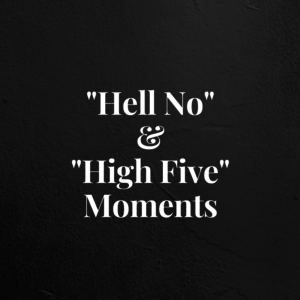Mary E. Marshall's Blog, page 19
September 4, 2018
Good Leadership Starts with Respect
 The annual Labor Day holiday weekend just ended, and the true meaning of this holiday is often lost as people now typically think of it more as a sign it’s the end of summer. The holiday was originally created to honor the Labor movement and the contributions workers have made. As a leader, it’s critical to remember the contribution of all who work for and with you – from the janitor who cleans your building all the way to your executive team.
The annual Labor Day holiday weekend just ended, and the true meaning of this holiday is often lost as people now typically think of it more as a sign it’s the end of summer. The holiday was originally created to honor the Labor movement and the contributions workers have made. As a leader, it’s critical to remember the contribution of all who work for and with you – from the janitor who cleans your building all the way to your executive team.
The CEO, Entrepreneur or head of the team is the one who sets the tone for how people are treated, and it starts with respect. Employees are not a means to an end, they are part of a team that is doing or delivering something that ultimately should serve everyone involved in the process. The shareholders, the executive management team and everyone who shows up every day to trade “work” of some kind for a paycheck.
When employees feel respected, they are much more likely to report job satisfaction – assuming they are paid fairly for what they do. When they report job satisfaction, retention and productivity go up. When these two measurements go up, so do profits. When profits go up, everyone wins. Or at least within an organization that really respects its workers, they will.
Good leaders understand that it’s not about them, it’s about what the team can do together and if it weren’t for the employees, nothing would happen. When we forget that no matter what job or task is being done, the person doing it deserves respect, we start to lose the respect of those who work for us. When we lose that respect, everything else just goes downhill. It’s easy to show this sort of respect for everyone when the organization has a mission-driven culture, so they are working for something greater than themselves. While most organizations are making products and services that may not be fulfilling an enormous mission like curing cancer they are still important to the everyday quality of life for all of us. We can’t forget this.
As a leader, when was the last time you walked the four corners of your company and talked with people? Picked up the phone and called your remote workers to see how they were doing? Told someone what you appreciated about them? Listened to the stories around the breakroom? Broke bread with your team? If it’s been a while, you need to get back to these basics. It can’t be an artificially contrived “walk” that is only done when you have guests, it has to be genuine. One thing everyone is pretty good at is detecting inauthenticity in leadership. Do you really care about them or only about yourself?
Start with respect. Start by acknowledging what people do every day to make your customers happy and to get products out the door. A simple “good job” goes a long way to showing that respect. A “thank you” goes even further. And remember, everyone watches the leader.
photo credit: marcoverch Calls for respect for black America at Franklin funeral via photopin (license) (cropped)
The post Good Leadership Starts with Respect appeared first on Mary Marshall // CEO Coach.
August 28, 2018
Good Leaders Know Everyone is Watching
 As a leader, you are always being watched. What you say, what you do, your reactions, your comments, your behavior, everything. Inadvertently passing someone without a “hello” or acknowledgment of their existence could be viewed as a slight by the receiver. Even though that was not remotely the intent.
As a leader, you are always being watched. What you say, what you do, your reactions, your comments, your behavior, everything. Inadvertently passing someone without a “hello” or acknowledgment of their existence could be viewed as a slight by the receiver. Even though that was not remotely the intent.
When I’m working with leaders, they are often surprised when I bring this up. In their minds, people should be able to know what they meant or what they were thinking. It’s just common sense, right? It might be common sense, but we can’t be in the minds of the people we meet or work with every day. We don’t know their frame of mind, what fears or doubts they have, what happened before they arrived at work. What would be “common sense” in a neutral setting, might be anything but given the baggage, everyone shows up at the office with.
Good leaders know that it’s up to them as the leader to be aware of and modify their own behavior given the circumstances, not the other way around. Smiles, frowns, jokes, hurriedness, tone of voice, words, etc. are ALL evaluated for what they might mean to the person on the receiving end. And usually, these interpretations are wrong, but they now create a new narrative about what the leader meant or wanted done. Some leaders feel like it’s a sign of strength to “leave them guessing.” It’s not. It’s a sign of a need for control. Some leaders never clean up their messes – intentionally or unintentionally – and either way, it creates chaos in the workplace and ultimately distracts from the goals.
John McCain knew how important this was and when he “messed up” or was wrong, he would always clean it up. He apologized and explained why he did what he did and why he had either changed his mind or clarified what he meant. He always “owned” his thoughts, words, and actions. This is what made him one of the few political leaders that truly had integrity and was respected, no matter which side of the aisle you were on. He wasn’t perfect, but he knew that he was on stage and that everything he did would be interpreted through some lens, so he wanted to make sure it was true to him. He didn’t take credit for others work, he always spoke up when he felt values or behavior were being violated and was respectful of others’ points-of-view. He didn’t make people feel wrong or wronged, he made sure he was heard and that he spent equal time listening to other perspectives.
Great leaders know they are being watched and are aware of the impact of their words, actions and intentions. Make sure that what you meant to convey is what you conveyed and clean it up if you didn’t – humility and humbleness are not a sign of weakness – they are signs of great leadership.
The post Good Leaders Know Everyone is Watching appeared first on Mary Marshall // CEO Coach.
August 19, 2018
Values Will Save You
 I can’t count the number of times I’ve brought up “values” with leaders of organizations as a way to solve a problem only to be met with a knowing smile. Then the leader goes on to explain what the organization’s values are and how they have contributed to the success of the organization and isn’t it great?! What they typically fail to see is that we were discussing a problem and that if the values had been lived, the problem would not exist.
I can’t count the number of times I’ve brought up “values” with leaders of organizations as a way to solve a problem only to be met with a knowing smile. Then the leader goes on to explain what the organization’s values are and how they have contributed to the success of the organization and isn’t it great?! What they typically fail to see is that we were discussing a problem and that if the values had been lived, the problem would not exist.
A great example of what I am pointing to is what has happened to Twitter. As this recent NY Times Op-Ed piece so eloquently points out, Twitter relies on its “rules,” not values to decide how to curate content. However, if they really enforced their values, it’s unlikely we’d have the online scream fests, shame conventions and downright mean-spirited and nasty behavior that has become commonplace on their platform.
To change behavior, all it takes is for one person to say “no, I don’t think so.” Then another to follow and then several others to feel it’s okay not to participate in whatever it is. But the initial “naming” of the behavior as not acceptable is the hardest part for most people to do, including leaders. It takes courage to do so and, in a workplace when one is not in a position of authority, it’s doubly difficult because the real loss might be the job and income to support oneself or one’s family. The cost can be high for saying no but I would argue it’s higher for saying nothing.
Most surveys of employees will tell you that fulfillment and happiness in the workplace are higher when the organization has a mission-driven culture or purpose, or that they are a part of something bigger than themselves. It’s meaningful. At the core of that meaning is a set of values that are being realized or lived. When we are in a state of flow, we are living out our values, our talents and who we were meant to be. Great workplaces live and die by their values – take Zappos for example. They have a very defined set of values that guide behavior and if you don’t like it, you leave, and they help you to do so.
However, even if your company doesn’t have an overarching purpose that is inspirational, it can help people achieve what they want, be who they are, and live their values. As the leader, you need to go first and don’t equivocate if it’s a value that the company was founded on. Be courageous and stand up for your values – rules follow values, not the other way around. You are the ultimate enforcer of the values by living them. If you don’t, they are not real lived values, they only exist on paper.
For everyone, considering the company we work for, the work we do, and the people we work with will instantly bring into focus whether your values are aligned or not. And if you’re not happy, it’s likely there is a significant values misalignment and time for a change. If you’re the leader, you can be courageous and make a stand for who and what your company is – values first.
The post Values Will Save You appeared first on Mary Marshall // CEO Coach.
August 14, 2018
You Are What You Tolerate
 Recently, I’ve had several conversations with leaders dealing with performance and behaviors that are out of alignment with the company’s culture and performance standards. The conversation usually starts with “I’m going to go ahead and make an exception this one time.” There are always valid reasons for the exceptions; the employee was having difficulties in their personal life, they are a key employee, the company has no one else to do what they do, this was an aberration, etc. Believe me, I’ve said or heard hundreds of various reasons for abdicating the standards that have been set.
Recently, I’ve had several conversations with leaders dealing with performance and behaviors that are out of alignment with the company’s culture and performance standards. The conversation usually starts with “I’m going to go ahead and make an exception this one time.” There are always valid reasons for the exceptions; the employee was having difficulties in their personal life, they are a key employee, the company has no one else to do what they do, this was an aberration, etc. Believe me, I’ve said or heard hundreds of various reasons for abdicating the standards that have been set.
First, let me say that exceptions do happen. Second, they should be very rare.
The problem with making these is that it’s a slippery slope to setting a new standard. This is how cultures and organizations shift into dysfunction without even knowing it. If it’s okay for so and so to do something against the company’s standards and values, why can’t I do it? Legally, you will get yourself on to shaky ground with claims of potential discrimination if you treat people differently. We have to ask ourselves if it was important to name it as a value or standard of behavior, why are we willing to tolerate something less than?
This becomes what we now tolerate, and our values are rendered meaningless. I had an employee who was cheating on his mileage, to the tune of thousands of dollars. When the dispatcher figured it out and brought it to my attention, I was shocked. My first reaction was to say, okay, he’s the only guy I have with certain certifications, so I’ll give him a warning. I called my HR firm and they rightly said, “so it’s okay for employees to steal?” I had to let him go. Had I not, I would have completely made a mockery of our values and standards of behavior – even though it was “inconvenient” to say the least. It was, however, the right thing to do, which has always been a guiding principle for me personally.
Leaders need to be first grounded in their own values and hold fast to that line – then holding others accountable to it as well. No exceptions except in very extreme circumstances and only if it would not change the goalposts for the organization itself. In my example, it was pretty clear what needed to happen. In most, it is much more nuanced, which leads to the culture bleed. As the leader, you are the first line of defense for your own and the company’s values – don’t let anyone change those. You become what you tolerate.
The post You Are What You Tolerate appeared first on Mary Marshall // CEO Coach.
August 8, 2018
The Power of Choice
 When I hear leaders say, “I have no choice,” I always remind them that in fact, they do. Everything we do in life is a choice, albeit sometimes the lesser of two evils, we always do have a choice. One of my favorite books called, “What Happy People Know,” discusses that one of the most critical differences between happy people and unhappy people is the belief that they have a choice. Unhappy people really believe they have no choice. So why does this paradox exist?
When I hear leaders say, “I have no choice,” I always remind them that in fact, they do. Everything we do in life is a choice, albeit sometimes the lesser of two evils, we always do have a choice. One of my favorite books called, “What Happy People Know,” discusses that one of the most critical differences between happy people and unhappy people is the belief that they have a choice. Unhappy people really believe they have no choice. So why does this paradox exist?
Personally, I think one of the biggest reasons for this is people frequently don’t want to take responsibility for the consequences of their decisions. By using the phrase, “I have no choice,” the consequences can be put on someone or something else. When a leader abdicates responsibility for his or her choice, they cease to lead. Nobody likes being wrong, hurting someone else, being seen as weak, etc., so the safe option is to say “I had no choice” thereby completely absolving oneself from responsibility for consequences. This is weak leadership. Strong leaders own their choices, recognizing at all times they are the ones making the choices. Not someone else.
So how do we shift our consciousness to realize that everything is a choice and that the possibilities are infinite? Sometimes not always great, but always endless. It starts with ownership and a realization that in the moment of decision – we own it. No one else, just us. In order to make the best decision, our decision, we need to look at all aspects.
What is the purpose of what we are trying to achieve or decide?
What outcome do we hope for?
Who else should have input?
What options do I/we have?
What are the consequences of each choice?
After the analysis, it usually comes down to a couple of options and sometimes only one will rise to the top of the decision matrix. This becomes your choice – not the only choice but your choice. You decided not to pick the others, so this clearly became the choice. Don’t minimize it by saying I had no choice, you did.
Even in very bad circumstances, you have a choice as to how you feel about something. You can choose victimhood – “it happened to me” – versus it happened and I can choose how I feel about it. Seeing a lesson in it is also a choice, choosing to let it rule your emotions is another one. The problem is we don’t always own our choices – ever heard someone say, “it’s out of my hands?” That’s actually a choice. You could have said, I gave my input and have chosen to abide by whatever is decided. Which is more empowering?
As leaders, it’s up to us to set the example. Owning one’s choices, and how you choose to react to those choices is leadership. If we want to have more accountable and responsible workforces, which leadership example will you use?
photo credit: Paul Iwancio IMG_3081 via photopin (license)
The post The Power of Choice appeared first on Mary Marshall // CEO Coach.
August 1, 2018
Leading through Uncertainty
 When leaders are uncertain, so are their followers. When a direction is not clear, or worse, a team is facing seemingly impossible odds, the natural reaction is fear. This is not a good combination because only through innovation can a solution be found, and fear pretty much stops innovation in its tracks. In the Harvard Business Review article, How to Lead When You Are Afraid, Peter Bregman writes about this and has some simple but profound steps for how to lead your way out of it.
When leaders are uncertain, so are their followers. When a direction is not clear, or worse, a team is facing seemingly impossible odds, the natural reaction is fear. This is not a good combination because only through innovation can a solution be found, and fear pretty much stops innovation in its tracks. In the Harvard Business Review article, How to Lead When You Are Afraid, Peter Bregman writes about this and has some simple but profound steps for how to lead your way out of it.
Step 1 – The first step is to build your ‘emotional courage.’ This means your ability to act thoughtfully, strategically, and powerfully while feeling afraid. This takes some practice and you are going to have to be comfortable, being uncomfortable. Remember – your team is watching and following your lead.
Step 2 – Focus on the process. Rather than focus on what is seemingly an impossible target, focus instead on the small incremental steps that will get you there. By starting with the first step in the process, the goal will eventually come into sight. Show your team how they can get to the goal. Bregman uses the example of “Sell Differently” vs. “sell x dollar amount.” Reframing the steps of the process will create a different thought process.
Step 3 – Communicate clearly. No one will move forward when there is ambiguity and when a goal is seemingly impossible, mushy communication will stop all innovative thought at the gate. Bregman identifies four components of clear communication: Vision, Empathy, Direction, and Proof. Try to include each of these elements in your written and spoken communication and you will have better results.
These are very practical steps to leading people forward when there is fear due to challenging circumstances and big goals. You will not achieve success if you, as the leader are not authentic about your approach and expected outcomes. It’s okay to say, “we might not make it.” Being realistic is good, giving up is not an option. Leaders must lead through difficulty a lot, it’s why they are in the positions they are in. It’s not for the faint of heart. And it certainly doesn’t mean that they “know” the answers. It does mean that they lead the team through an innovative process that at least gives air to alternatives to the “impossible.” Most things that we have or do today were once considered impossible and it’s only the rare leader who isn’t at least a little afraid at the start. Resilience and emotional intelligence are built by leading through fear – not when it’s easy.
The post Leading through Uncertainty appeared first on Mary Marshall // CEO Coach.
July 24, 2018
The Art of Curiosity
 Although curiosity is one of my core values, I often find myself instantly going to “what I know to be true” in business and personal situations. The older we get, the more experience we get, the more sure we are that we “know” what the right answer or direction is. In fact, as helpful as the hard-won experience is, curiosity is more powerful for two reasons. The first is that often we are not listening to the whole situation or problem and therefore answering or solving the wrong problem. The second is that true innovation only comes from curiosity about a different or better way to do something.
Although curiosity is one of my core values, I often find myself instantly going to “what I know to be true” in business and personal situations. The older we get, the more experience we get, the more sure we are that we “know” what the right answer or direction is. In fact, as helpful as the hard-won experience is, curiosity is more powerful for two reasons. The first is that often we are not listening to the whole situation or problem and therefore answering or solving the wrong problem. The second is that true innovation only comes from curiosity about a different or better way to do something.
The saying goes that, “perception is reality.” What we should say is that my perception is my reality. It’s not reality for everyone so to generalize is to make a whole boatload of assumptions that only fit our own narrative. Just take today’s toxic political environment. Everyone is stuck in their own vastly different reality and yet these different points-of-view can’t all be “the truth.”
The first reason we are not curious is inadequate listening. It causes us to immediately check our own internal information bank and click on the first solution that pops up based on our experience. Our brain is like Google and picks the thought that matches the best – albeit without the influence of paid advertising. So, what if we learned to just pause, and hold “that perfect right answer” or solution just half a beat to consider whether we are actually solving the right problem? It doesn’t take a lot of time to hold back offering an opinion and getting all the information. This is what smart leaders do. They ask lots of questions like, “tell me more,” “what makes you say that,” “what have you considered,” “which direction are you heading,” “can you frame the question as a ‘how do I or how to’ question?” You’ll be surprised at what you find out. Curiosity, in this case, does not kill the cat. It will likely solve the right problem.
The second reason to become more curious is that true innovation only happens through “not knowing.” In this state, we are able to look at the situation or problem from multiple angles and play “what if.” Some of these solutions will be non-starters but somewhere in there is a gold nugget that if we recognize and work with it, can turn into a gold mine. What if we did it a different way? What if the current barrier were not there? Often, we look at the challenges with all the barriers we have today – lack of money, time, people, expertise, etc. Try assuming those problems are solved and be curious about what can be created – not what already has been created and works – but what can be created for tomorrow. Being curious is the only way to tease out the possibilities.
Next time you are faced with a problem or situation that you think you have the answer to, just pretend that you don’t “know.” Ask questions and be curious about what if’s and what could be. You just might be on your way to something great.
The post The Art of Curiosity appeared first on Mary Marshall // CEO Coach.
July 18, 2018
“Hell No and High Five” Moments
 When trying to define what our individual values are, there are three things I have found helpful. First, there are those pivotal stories that make up our foundation – the stories that “define” a moment for us. These stories are ones we remember as instrumental in shaping who we are and how we think. In each of these stories is a value we decided was important and became ours. The other two ways to identify values are in what we call “Hell No” and “High Five” moments. “Hell No” moments are those in which we decided not to do something, not to allow something to happen, and simply said “Hell No.” A value was likely about to be violated if we did not say no. A “High Five” is a moment we celebrate for some accomplishment or pivotal moment that had meaning. At its core, there is a value being celebrated.
When trying to define what our individual values are, there are three things I have found helpful. First, there are those pivotal stories that make up our foundation – the stories that “define” a moment for us. These stories are ones we remember as instrumental in shaping who we are and how we think. In each of these stories is a value we decided was important and became ours. The other two ways to identify values are in what we call “Hell No” and “High Five” moments. “Hell No” moments are those in which we decided not to do something, not to allow something to happen, and simply said “Hell No.” A value was likely about to be violated if we did not say no. A “High Five” is a moment we celebrate for some accomplishment or pivotal moment that had meaning. At its core, there is a value being celebrated.
Last October, Senator John McCain demonstrated a perfect example of a “Hell No” moment during his speech at the National Constitution Center in Philadelphia. It was a brilliant speech, forcefully delivered from a man who throughout his career has shown honor and integrity in all that he has done. Honor and service were the values he stood up for in his “Hell No” moment, as he has throughout his life. Regardless of your political views, this is a man who would never dishonor his country, his fellow citizens or himself.
“We live in a land made of ideals, not blood and soil. We are the custodians of those ideals at home, and their champion abroad. We have done great good in the world. That leadership has had its costs, but we have become incomparably powerful and wealthy as we did. We have a moral obligation to continue in our just cause, and we would bring more than shame on ourselves if we don’t. We will not thrive in a world where our leadership and ideals are absent. We wouldn’t deserve to.”
Few of us will have a national stage to show such leadership in action and to stand up for our values in such a powerful way. However, we all have the ability to make an impact on a daily basis within our spheres of influence. Leaders are watched closely. Everyone is looking for proof or disproof of a leader’s stated values. The minute an equivocation happens on a stated value it becomes moot or morphs into something else. This is not lost on those who observe. As a leader, it is paramount that we own our values, that we show through our word and deed that we live them. We let “Hell No” moments show others what we will not tolerate and what we stand for. By doing so we are not only true to ourselves but showing others the power of values and demonstrating how they might stand up for theirs.
“Hell No” moments don’t need to be public, they need to be real. The lines we do not cross in private are often more powerful than those that are public. Your values are those lines.
The post “Hell No and High Five” Moments appeared first on Mary Marshall // CEO Coach.
July 12, 2018
Who Are You As a Leader?
 Leadership is the hot topic these days – who should be the leader? How should they lead? What is leadership behavior? All good questions and depending on your perspective, there are multiple good answers. When someone asks me about “leadership” or what type of “leader” they should be or what does a successful leader look like, I usually start by asking “who” they are, meaning, who are they personally? Professionally? What do they believe and stand for? All of these make up their character and if you don’t lead with congruency to your own character, it’s game over.
Leadership is the hot topic these days – who should be the leader? How should they lead? What is leadership behavior? All good questions and depending on your perspective, there are multiple good answers. When someone asks me about “leadership” or what type of “leader” they should be or what does a successful leader look like, I usually start by asking “who” they are, meaning, who are they personally? Professionally? What do they believe and stand for? All of these make up their character and if you don’t lead with congruency to your own character, it’s game over.
So many leaders try to fit into a mold they believe is what a good leader looks like – which may or may not fit with who they are. If you try to lead in a way that is not consistent with your values, you won’t be leading for very long. Like a dog who can sense fear in a human, those who follow can instantly sense inauthenticity in a leader. A disconnect between what they say and what they do. There is not a costume you can don to put on your “leadership” and instantly transform like Clark Kent into a super leader. The only “costume” is the one you wear all the time.
Character is defined by Webster’s as “the mental and moral qualities distinctive to an individual.” People look to leaders to have qualities like integrity and authenticity and these are all part of what makes up character. Leaders who lead with their own character and values are so far ahead of the rest of the pack that it looks like they got a mile head start. Don’t worry about what people think of you or how you are going to look. If your character and values are your guides, you will always do right by you and usually by others as well.
People make the choice to follow a leader – or not – if they believe the leader has the ability to help the organization and its people get somewhere they could not or would not get on their own. The leaders that have what they believe to be character will be the ones they follow even though they may not truly believe or understand the mission or the “how” of the situation just yet. The decision relies on the willingness to “trust.” At the heart of every leader we follow is that for now we “trust” them more than we trust ourselves to go it alone. When trust breaks down, the followers go away. Even worse, they can rebel, and chaos can ensue.
Leaders start by trusting themselves, being true to their character and values and doing the right thing (to the best of their ability or knowledge). Whether leading an organization, a group, your family or yourself, the easiest path is to start by leading with your own true self – your character.
The post Who Are You As a Leader? appeared first on Mary Marshall // CEO Coach.
July 3, 2018
4 Key Steps to Keep Your Strategic Plan Alive
 Yes, it’s that time of year again to dust off the old strategic plan, or goals and see how you are doing. If you’ve been doing this monthly or quarterly, or even better bi-weekly, good for you, but you are in the minority. It was Eisenhower who said, “Plans are nothing, planning is everything,” and he was right.
Yes, it’s that time of year again to dust off the old strategic plan, or goals and see how you are doing. If you’ve been doing this monthly or quarterly, or even better bi-weekly, good for you, but you are in the minority. It was Eisenhower who said, “Plans are nothing, planning is everything,” and he was right.
There are 4 key steps to keep your strategic plan alive and current:
Review
Revise
Reinvent
Repeat
I often go into companies and they are so busy doing business, meaning day-to-day operations, etc., that the goals they set out at the beginning of the year have ended up ignored. Don’t get me wrong, these companies are having some success and things are going along well, but what if more attention had been paid to those nicely laid out plans? Would they have achieved that extra 10% top or bottom line? Would they have added that crucial market sector they have been after for years? The reality is, it’s doubtful. Let’s consider why.
Continuous planning coupled with execution is one of the keys to business success. If you plan at the beginning of the year and never adjust you are always reacting to what’s happening instead of making things happen. To change this trajectory start by reviewing what you thought you wanted to accomplish this year – how did you do? What happened? What can we learn from that? The next step is to revise, change what didn’t work, and come up with some new ideas or strategies that might work. Or maybe the goal or strategy itself was not a good one, so chuck it out and come up with something more relevant.
Of course, it goes without saying that you don’t want to do this process of review and revise in a vacuum. You may be the owner or head of the company, but that doesn’t mean you have all the best ideas. The ideas are in the room. They are from your managers and employees whom you have hired and put faith in. Listen to what they have to say and shape it into a plan that everyone can get behind.
Step 3 is to reinvent. So often we are caught in our plan because of our beliefs around “what is.” It colors our beliefs about what “could be.” When I facilitate planning exercises, I tell people to think 3 years ahead and color in the picture for me of what the company looks like, who the customers are, what products are you selling and to whom, etc. But NOT based on the facts of today, based on the possibilities of tomorrow. It’s only in our belief that something can happen that it will. So reinvent the future, not by the rules or restrictions of today’s landscape, but by the possibilities not yet imagined.
This doesn’t need to be a long drawn out process, you need a competent facilitator (preferably not you, the owner or leader) and a target of where you want to go. The bones of a plan that can be implemented and an easy process for getting there. Too much complexity in the strategic plan and everyone will lose interest. Keep it simple and executable. And remember to build in your review times so you can revise and reinvent, and then finally, repeat!
The post 4 Key Steps to Keep Your Strategic Plan Alive appeared first on Mary Marshall // CEO Coach.



